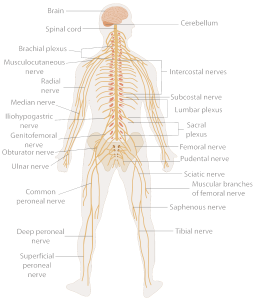 Pain is a sensation that is triggered in the nervous system. It can be sharp or dull and last for short or long periods. Pain may be localized to a specific area of the body such as the abdomen, chest or back or it can be felt all over the body, such as when a person experiences all over muscle ache as a result of flu.
Pain is a sensation that is triggered in the nervous system. It can be sharp or dull and last for short or long periods. Pain may be localized to a specific area of the body such as the abdomen, chest or back or it can be felt all over the body, such as when a person experiences all over muscle ache as a result of flu.
Pain serves as a warning that something is wrong and can help in diagnosing a problem. Without pain, a person would be unaware that they had hurt themselves or that they have a medical problem that requires treatment. In most cases, pain ceases when the problem is treated and this type of pain is called acute pain. However, in some cases people experience chronic pain, which is constant pain that last for weeks, months or years. This might be due to an ongoing problem such as arthritis or cancer but sometimes the cause cannot be identified.
Over the years, researchers have elucidated the bodily processes that lead to the pain sensation. In the case of acute pain, which occurs as a result of injury, for example, the pain pathway is as follows.
If a person pricks their finger on something sharp, for example, this causes tissue damage. This damage is registered by nociceptors, microscopic pain receptors in the skin. Each pain receptor is present at one end of a nerve cell or neuron and is connected to the other end in the spinal cord by a long nerve fiber called an axon.
Nerve fibers exist in bundles to form a peripheral nerve. Within this peripheral nerve, electrical signals are passed along the neuron to the spinal cord in the neck.
In one area of the spinal cord called the dorsal horn, electrical signals travel between neurons via junctions called synapses, which is achieved by means of chemical messengers called neurotransmitters. The signals then travel up the spinal cord to reach the brain.
The signals are passed to a part of the brain called the thalamus, which then distributes the signals to different brain compartments. These brain areas include the somatosensory cortex, which is responsible for physical sensation; the limbic system which is linked to emotions and the frontal cortex, which is responsible for thinking relating to personality and consciousness.
2016
Continue reading the full article from News Medical Life Sciences here.

